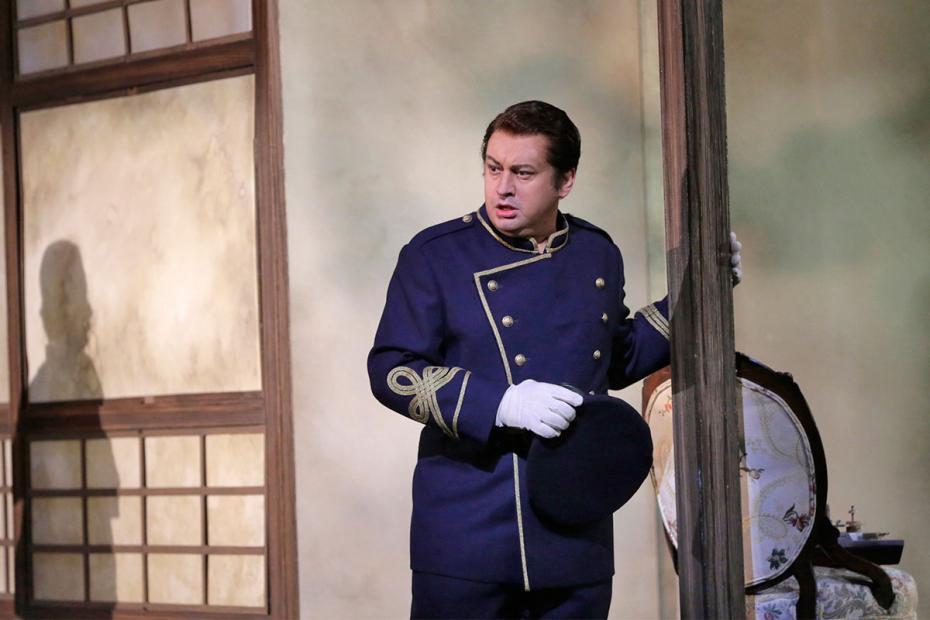Why has Madame Butterfly endured within the modern opera repertory and become a favorite of audiences throughout the world? One reason might be that the immensity of the tragedy carries audiences to new emotional depths. The story of an innocent and pure love, carelessly betrayed with heartbreaking results, binds the audience to the emotions of the unfortunate Cio-Cio San, the Japanese bride known as “Butterfly” to her family, whose sad life is played out during the opera.
What begins as an idyllic liaison in an enchanting land of cherry blossoms in Act I becomes the heart-wrenching trajedy of an abandoned bride forced to make an excruciating decision by the end of the opera. Puccini’s dramatic and romantic score perfectly accentuates the emotional highs and lows that Cio-Cio San feels.
The Los Angeles Opera recently presented a new production of Madame Butterfly, which was originally designed for and created by the Santa Fe Opera. The set features a pivoting, Japanese-style house with sliding screens that is located at the heart of center stage where all of the action occurs and serves to maintain focus on the characters involved with the story.
The strength of the portrayal of Cio-Cio San is clearly integral to the success of any production of this opera. Ana María Martinez certainly deserves the accolades being heaped upon her for her interpretation of Cio-Cio San. The depth of feeling she portrays is beautifully expressed in her performance.
But, what about the role of the American Lieutenant Benjamin Franklin Pinkerton, who abandons his Japanese wife? Isn’t that role also crucial to the story? For the audience to be drawn into the emotions triggered by the trials of Cio-Cio San, the role of Pinkerton is pivotal and requires more subtlety than it might seem given that he is painted as the villain.
Pinkerton is initially smitten by his new young bride, who with his encouragement, opens her heart and expresses her love for him. In turn, that confession touches Pinkerton deeply and the result is a brief, but tender, encounter between the two as Act I closes.
Through the rest of the opera we follow Cio-Cio San on an emotional roller-coaster. As a counterpoint to her anguish, Pinkerton must also show his true feelings, at times deeply affected by Cio-Cio San’s entreaties, yet resolute in his desire to return to his accustomed life in America.
Tenor Stefano Secco has sung the role of Pinkerton more than 150 times and brings his skillful and subtle interpretation of this role to the stage. Just as there is intensity between the characters, there is also lovely interplay between the voices of Stefano Secco and Ana María Martinez.
During a brief interview conducted in Los Angeles, Stefano shared his thoughts:
Q: What drew you to this production?
Stefano Secco:
First of all, I have to say that I love this classical production. I understand every character well since they are being interpreted just as the librettist created them, and the classical staging complements the music and libretto very well for this big work by Puccini.
What do you contribute personally to the production?
I have interpreted this role perhaps more than 150 times. In this particular production, Pinkerton is portrayed as very much an egotist, perhaps more so than in other productions. It seems that the character of Pinkerton in this context is a bit cruel when I look at him from my own personal perspective, yet it is my job to play that character faithfully.
Do you think Pinkerton loves Cio-Cio San?
Unfortunately, I would have to say that Pinkerton doesn’t really love Butterfly. But, in the first act he does have a joyful experience with her. There is a sparkling quality to the closing scene of the first act. The attitude at that point onstage is: “us against the world”. Afterwards, though, it is very difficult for Pinkerton, especially when he realizes the error of his ways.































